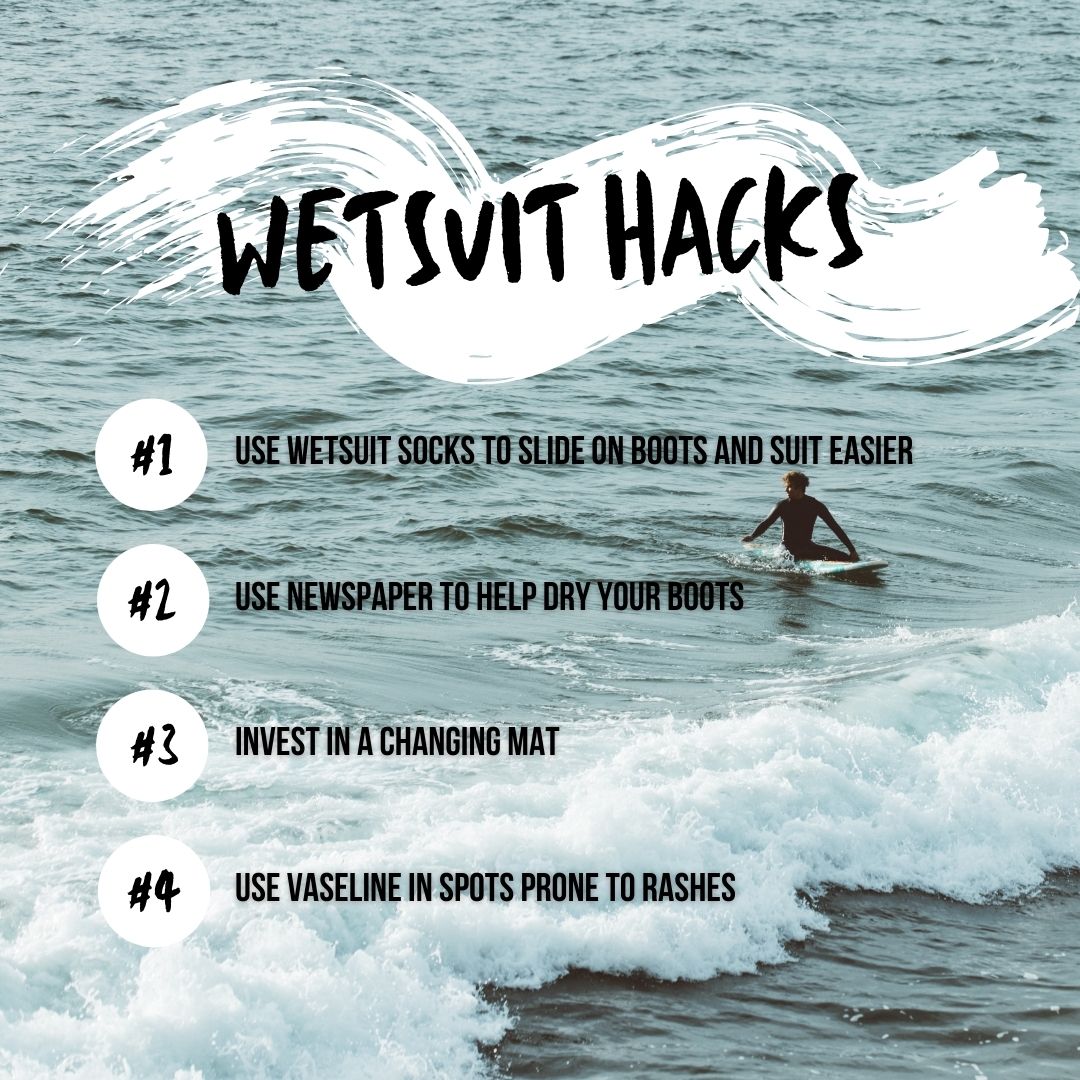Wetsuit Hacks
Paige Rosenthal November 3rd, 2020 Posted In: Articles
Wetsuit Hacks
Whether fighting to get your wetsuit on, struggling to stay warm, or trying every method to get it dry quicker, there are plenty of things to think about before you start surfing.
Seasoned surfers — through many trials and tribulations — have uncovered simple hacks to make life easier. For novice surfers, these may be simple, yet mind-blowingly effective tips you’ll be thankful for. So, let us do some of the legwork for you.
Here are a few wetsuit hacks that you need to know:
Use wetsuit socks to slide on boots and suit easier
For one, wetsuit socks are a great addition for surfing in cold temperatures because they help insulate feet and protect them from outer elements. They are also a fantastic tool to help slip into your wetsuit and wetsuit boots with ease. There are varying sizes depending on what you need, including knee-high socks that are really helpful for getting into a wet wetsuit. Having this extra layer covering over your feet and legs will help you glide right in, where you otherwise would have to fight to get comfortably inside.
If you don’t have wetsuit socks on hand, don’t fret. Plenty of surfers will just grab a plastic bag and wrap it over their foot before sliding into the boot. While it certainly doesn’t compare to a pair of neoprene wetsuit socks, it will get the job done until you can order a pair.
 Use newspaper to help dry your boots
Use newspaper to help dry your boots
If your boots don’t dry quickly enough, you’re in for that wonderful smell of moisture that will stick around. So, it’s important to get them as dry as possible, as soon as possible. A newspaper is a great tool to help move the process along. After rinsing with freshwater and drip drying, stuff old newspaper inside the boots. The newspaper will help absorb the moisture still lingering in your boots.
Put your car heater to work
Use the car ride home to begin drying out your gear. Once you’ve rinsed your wetsuit and boots with freshwater to get corrosive salt off of the neoprene, lay the wetsuit and boots on top of a towel on the floor of your car. Crank the heat up and direct the heat down by your feet to flow the hot air along the floor of the car. The hot air will help draw out moisture to dry out your suit and boots. And, as an added bonus, your toes will stay nice and toasty on the ride back home.
Bring a bottle of warm water with you
Fill up a bottle of warm water at home and bring it to the beach to use when you’re changing out of your wetsuit. Not only will it be a welcomed warmth after leaving cold water, but it will rinse off your wetsuit from the harmful saltwater of the ocean. A recycled laundry detergent bottle is a great option, and if you’re especially crafty, punch a few holes in the top of the bottle and you’ll have a DIY shower for after your day on the water.
Use Vaseline in spots prone to rashes
Vaseline is really the best treatment (outside of wearing a rash guard) for dealing with a rash underneath the wetsuit. The petroleum jelly provides a slippery layer between your skin and the neoprene, allowing it to slide easily and avoid rubbing, creating more irritation and ultimately making the rash worse.
Invest in a changing mat
Changing out of your wetsuit on the sand will get your wetsuit very sandy. But, if you change in the parking lot you run the risk of ruining your wetsuit. Since many other surfers have run into this dilemma, there is now a solution: the changing mat. Bring your mat to the beach and stand on the round, protected surface of the mat when you’re taking off your suit. You’ll avoid an overly sandy wetsuit or the potential harm of the gravel parking lot.
For some privacy, bring a changing towel
If you’re not the exhibitionist type, you might want to buy a changing towel to make taking off your suit at the beach a bit easier. These hooded towels look like giant rain ponchos but made of warm towel material. They have armholes and cinch at the waist, keeping you covered from front to back as you peel off your wetsuit. Now, you can change in privacy and also avoid tracking sand, gravel, and dirt into your car.
Life on the water and the transition from surf to sand is made much easier with these simple wetsuit hacks. As your second skin on the water, caring for your wetsuit is key to extending its life as staying protected when surfing.


With many wetsuits neoprene is between colored fabric.
Yes, Scott, you’re right. Most wetsuits are closed cell wetsuits. All of the wetsuits we currently carry are closed cell.
However, there are more and more wetsuit with other colors such as blue and green. You can find them in Amazon.
Thanks for sharing. You can also find them here on our website, and rest assured knowing that our wetsuits are of good quality and our customer support is top notch. Here’s a list of men’s wetsuits we currently have in other colors aside from black: https://www.wetsuitwearhouse.com/wetsuits/category/mens-wetsuits-general.html?InStockColors=Blue&InStockColors=Red&InStockColors=Green&Per_Page=24&Sort_By=bestsellers&suit_type=Fullsuits&suit_type=Shorty%20Springsuits